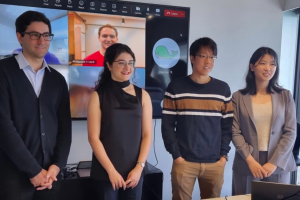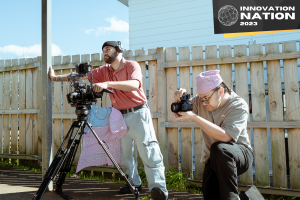Interview: Matt Calkins – How a startup with no product, made it As a global tech leader

Richard Liew talks to Matt Calkins, cofounder and CEO of US listed technology company Appian (NASDAQ: APPN), about bootstrapping, business ideas, game theory and robot CEO’s.
Started by four friends at the start of the dotcom bust, Appian employs 2000 people worldwide and is today recognised as a global leader in the low-code space, helping businesses design and automate their most important processes.
But it wasn’t always this way. One of Appian’s very first ever commercial projects turned out to be their largest ever and most complex to date – and through unplanned circumstances led to the development of the largest intranet portal the world had ever seen. This project could have broken the business, but instead the lessons from this helped shape the business into what it is today.
Richard Liew spoke to Appian cofounder Matt Calkins from his office in Washington DC.
Richard Liew: The Appian story is a classic “basement to IPO” entrepreneur story – can you paint a picture for us of how you started the company in 1999?
Matt Calkins: Actually our first address was my one bedroom apartment. And obviously that wasn’t a very good place to have a few employees over. So when we grew a little bit, I bought a home that had a basement so that we could become a basement company. We worked there for about six months.
RL: What was your first product or service?
MC: Well we knew we wanted to make a product, but unfortunately it takes money and time to make a product, and we didn’t have those things. So instead, we had to begin as a services firm and an analyst firm selling our opinions and our expertise rather than a product. We needed a short work-to-cash cycle otherwise we would’ve had to find cash some other way. But we had decided we wanted to grow with customer money rather than investor money. So under that constraint, we were not able to begin in product even though we wanted to end in product.
RL: So essentially you decided to start a software company but didn’t have any idea what kind of software?
MC: We had no product idea. We had no capital, we had no business plan, and I never did write one. And amongst the four of us, none of us had a computer science degree or even a science degree, and we were all in our twenties. We weren’t interested in building a company that ran at a loss and didn’t make a product anybody wanted and that just rode the wave of trendiness. We wanted a real company that made money, satisfied customers and would grow legitimately based on the value it was adding to the world.
RL: What did you do to find your first customer?
MC: Well I was our sales department at the beginning, and in fact, I was our sales department until we were about 30 people. I made a lot of cold calls. I got back in touch with contacts. I was good at building databases, and I was kind of a teacher of the methodology by which my former company made data warehouses. So I had some ability to get consulting gigs, tuning large databases that were built for reading data, not writing. That got us a little bit of business in a few places, and I was easily able to coach some new employees on how to build and deploy business databases and business intelligence software.
But of course that isn’t the business we wanted to be in. That was just a way to start. So we had to adapt our strategy a couple of times, and it took us years to find the industry that we’re in today. We were adaptable and flexible, and we were willing to learn new things and explore and see where we could create some value.
In the end, our “revenue-first” mandate helped us very much, because where there’s revenue, there’s also education. If you force yourself to be useful enough to a client that they will pay you money, you’ve figured out what’s valuable and what industry is not fully served already. So by committing to make a profit from the beginning, we forced ourselves to discover areas where there was a need, and at the same time build our reputation in those very areas and give us exposure to the problems that existed in those areas, and give us enough of a profit so that we could invest in creating a product that addressed those areas.
In a way, you could say that our story began with a commitment, and the commitment was, we will make money from the beginning.
RL: It sounds like just by making that commitment you said, “We’re going to make money and we’re going to do this by solving real problems,” and you basically went out and found problems to solve and did it on the fly. That flies in the face of what a lot of people would think is needed to start a successful business.
MC: I’ve got another way to put it actually. If you ask most people what they think they need to start a company, I think a bunch of them would say, you need a great idea. That’d probably be answer number one, but a bunch of others would say, you need an investor. And I think it’s funny to consider that we had neither.
Maybe really, the asset with which you would most want to begin a business is a customer, not an idea or an investment. Because a customer has problems to be solved and will pay you if you solve them. And so that’s your source of revenue. You don’t need an investment. You got a customer, you got revenue, right?
RL: Can you talk about one of your first big projects, Army Knowledge Online? Am I correct in that it was the world’s largest intranet at the time?
MC: It was called that in a major publication so I accept that. Army Knowledge Online was one of our breakthrough moments as a company. Our first business direction had recently blown up. But we thought our next big opportunity was going to be portals for enterprise. We would have a portal, like an internet that employees would log into, and they would get the news they needed to know about their part of the company. Customers that had a relationship to them, results from their region, news about things that touched on their expertise, their geography, their bonus plan. It would essentially be corporate information targeted individually to each employee. You could call it a smart portal.
And at the moment we were getting into that new business, the United States Army had a need.
It turned out that they were decentralised information wise. And so not only was information not served up perfectly to the person as they needed it, it was actually in some cases exceptionally hard to acquire. They were so decentralised, in fact, that if you were a soldier and you transferred from one base to another base, you literally had to get a new email address. And so the Army thought they should probably fix that.
They knew that they were starting at a difficult place with extreme fragmentation, and they needed unification. They needed it fairly quickly. They wanted something effective. And so they decided that the standard for the entire army should be Appian software. It still amazes me that this happened. There was a force-wide order declared by the guy who ran the entire army, General Shinseki, who I had never met. I had never spoken to him. I mean, on no sales call, had I ever gotten close to this guy. And he makes a declaration that literally every soldier in the Army is obliged, ordered to have an Appian “Army Knowledge Online” account.
It was a gutsy move, but it was a good move actually, because our technology really was good, and we were extraordinarily dedicated to making it work. And we did make it work. And it became one of the most successful projects in the history of the US military with billions of human log-ons over the next decade.
RL: You’re a champion board-gamer and have written a couple of board games yourself. What is your favourite board game?
MC: Yes I have a new board game coming out soon called Charioteer. It’s about racing and it’s a fast, easy, strategic game. As for my favourite game that I did not write, I like business games, particularly if they’re a little bit on the heavy and complicated side. ‘Acquire’ is exceptionally elegant. Plays in an hour, maybe an hour and a half, and still gives you plenty to think about. It’s a classic, more 50 years old at this point, written by Sid Sackson.
RL: What lessons or strategies from board games might be transferable to entrepreneurship?
MC: Well, you can’t play business like a game. It doesn’t work. And being a great gamer does not make you a great business person. They are somewhat different skills. The main difference being that a game is fully understood by its players, at least if you’re a good player, you know all the rules, you know all the cards, you know what the board is. Games generally are fully comprehended, and they resolve in a polarised outcome… “I’ve won” or “I’ve lost” in a few hours. Whereas a business is full of decisions, the outcomes of which cannot be predicted because we don’t know the rules. The rules are always changing, and there will not be a polarised outcome, which means it’s sort of up to you as a business person to diagnose the likely effects of the things that you do.
A game makes it really easy to figure out why things happen, because it gives you that educational polarised outcome, and business doesn’t. So the most obvious question, “Can you play business like a game?” The answer is no. However, game authorship and business organisation are not so different. Building a mechanism that achieves certain ends can be done either as a game or a business. And so there’s a parallel. Being a designer of a game is a little bit like being the designer of an organisation.
RL: Appian’s “platform as a service” offering enables organisations to automate many complex processes. Can you see a time when maybe we do have robots as CEOs with the way technology and AI is tracking?
MC: I don’t think so. AI’s got a critical weakness. It’s not a good learner. AI may look really smart, but you have to feed it an unbelievable amount of data before it gets smart.
Give me, let’s say one hour’s experience of driving a new kind of car and I’ll be decent at it, right? But take one hour’s worth of data and feed it into an AI algorithm and see if it can drive that car? Not at all. An AI algorithm needs a million hours of data before it can drive that vehicle. And look, if you have a million hours of data in your database and the rules of the road haven’t changed then go ahead, feed it into an AI algorithm and let it be the world’s best driver.
But imagine if the rules of the road were always changing. Today, we’re driving on a different side… today, stop means go… imagine how bad AI drivers would be if their data set were being constantly invalidated in a random way. They would be truly horrific drivers and a danger to us all, which is why AI is only good at things for which the rules don’t change. And in real life, in human interactions, in business, in politics, in social things, it is the nature of us that we are always changing the rules. Fashion is a thing. What worked last year, you shouldn’t wear this year, right? Not if you’re fashionable. The rules change and sometimes they change just because we prefer change to the status quo. And other times they change because, because the technology has advanced.
This is why artificial intelligence is great at games and terrible at business. Nobody’s got a robot for a CEO, but lots of games have a robot for a champion. I mean, if robots are so great at games, and games are like business, then, then why isn’t (IBM’s chess-playing mainframe computer) Deep Blue the CEO of Microsoft? And the reason is it’d be terrible at it because the rules keep changing in business.
There’s some kind of threshold there where robots can never be CEOs. They could be great assistance, they could fetch you data, they can contribute, and which, which all ends with my core belief about AI, which is it’s going to be an unbelievably powerful, useful entity low in the stack. It’ll be an identifier, an advisor, an appraiser, a translator. It’s going to do all those things wonderfully well because those do not require human judgement and interface with a changing world.
But human society is not static. The rules are not always the same. The data set is constantly invalidated. And if we don’t have enough time to gather data with the new rule set, AI won’t catch up. [In fact] there’s a certain point of change in the rules at which AI never catches up. If the rules change by 1% a year maybe AI catches up pretty fast, but if they change by 5% a year, maybe AI literally never catches up.








